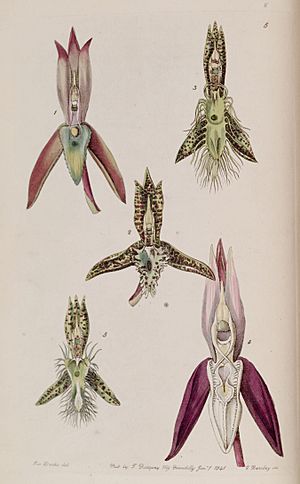Scaled catasetum facts for kids
Quick facts for kids Scaled catasetum |
|
|---|---|
 |
|
| Scientific classification | |
| Genus: |
Catasetum
|
| Species: |
laminatum
|
| Synonyms | |
|
|
Catasetum laminatum, also known as the scaled catasetum, is a fascinating type of orchid that grows naturally in Mexico. Orchids are a huge family of flowering plants, famous for their beautiful and often unusual flowers. The Catasetum laminatum is one of these unique plants, known for its special way of spreading its pollen.
Contents
What is Catasetum laminatum?
Catasetum laminatum is a specific kind of orchid. The name Catasetum comes from Greek words meaning "down" and "bristle," which refers to two antenna-like structures on the flower. Laminatum means "layered" or "scaled," likely describing a feature of its petals or lip. This orchid is an epiphyte, meaning it grows on other plants, like trees, but it doesn't harm them. It uses the trees for support to reach sunlight.
Where Does It Grow?
This special orchid is native to Mexico. It thrives in warm, humid environments, often found in tropical forests. These forests provide the perfect conditions for orchids, with plenty of moisture and dappled sunlight filtering through the tree canopy. It's usually found at moderate elevations, where the air is moist and temperatures are stable.
What Does It Look Like?
Catasetum laminatum has a unique appearance that helps it survive and reproduce in its natural habitat. Like many orchids, it has interesting parts that make it stand out.
The Amazing Flowers
The flowers of Catasetum laminatum are truly remarkable. They can vary in color, often having shades of green, brown, or yellow, sometimes with spots or stripes. What makes them truly special is their shape and how they are designed for pollination. The "lip" of the flower (a modified petal) is often helmet-shaped or sac-like. This orchid is also known for having separate male and female flowers, which can look quite different from each other. Sometimes, a single plant can even produce both types of flowers!
Leaves and Pseudobulbs
The leaves of Catasetum laminatum are usually long, thin, and pleated. They grow from structures called pseudobulbs. Pseudobulbs are swollen stems that act like storage tanks for water and nutrients. This helps the orchid survive during dry periods. When the plant is actively growing, the pseudobulbs are plump and green. After the growing season, the leaves might fall off, and the plant rests, relying on the stored energy in its pseudobulbs.
How Do Catasetum Orchids Reproduce?
The way Catasetum orchids reproduce is one of the most amazing things about them. They have a very clever and active method of pollination.
Pollination: A Tricky Business
Unlike many flowers that passively wait for pollinators, Catasetum orchids have a special "trigger" mechanism. When an insect, usually a bee, touches a sensitive part of the flower, the orchid quickly shoots out its pollinia (packets of pollen) onto the insect's back. This happens with surprising speed and force! The bee, now covered in pollen, then flies to another Catasetum flower, hopefully a female one, and transfers the pollen, leading to fertilization. This unique "trap and shoot" method ensures that the pollen is accurately delivered.
Life Cycle of an Orchid
The life cycle of Catasetum laminatum begins with a tiny seed. Orchid seeds are incredibly small, like dust, and need a special fungus to help them germinate and grow. Once a seedling starts, it develops pseudobulbs and leaves. The plant grows and matures, eventually producing flower spikes. After pollination, if successful, a seed pod forms, which will eventually release thousands of new tiny seeds into the wind, ready to start the cycle all over again. This cycle is closely tied to the seasons, with growth during the wet season and a resting period during the dry season.
Why Are These Orchids Special?
Catasetum laminatum and other Catasetum orchids are special for several reasons. Their active pollination mechanism is one of the most complex and fascinating in the plant kingdom. They also show sexual dimorphism, meaning male and female flowers look different, which is unusual for orchids. Their ability to store water in pseudobulbs allows them to survive in environments with changing rainfall. These unique features make them a favorite among orchid enthusiasts and a wonderful example of nature's clever designs.
See also
 In Spanish: Catasetum laminatum para niños
In Spanish: Catasetum laminatum para niños

